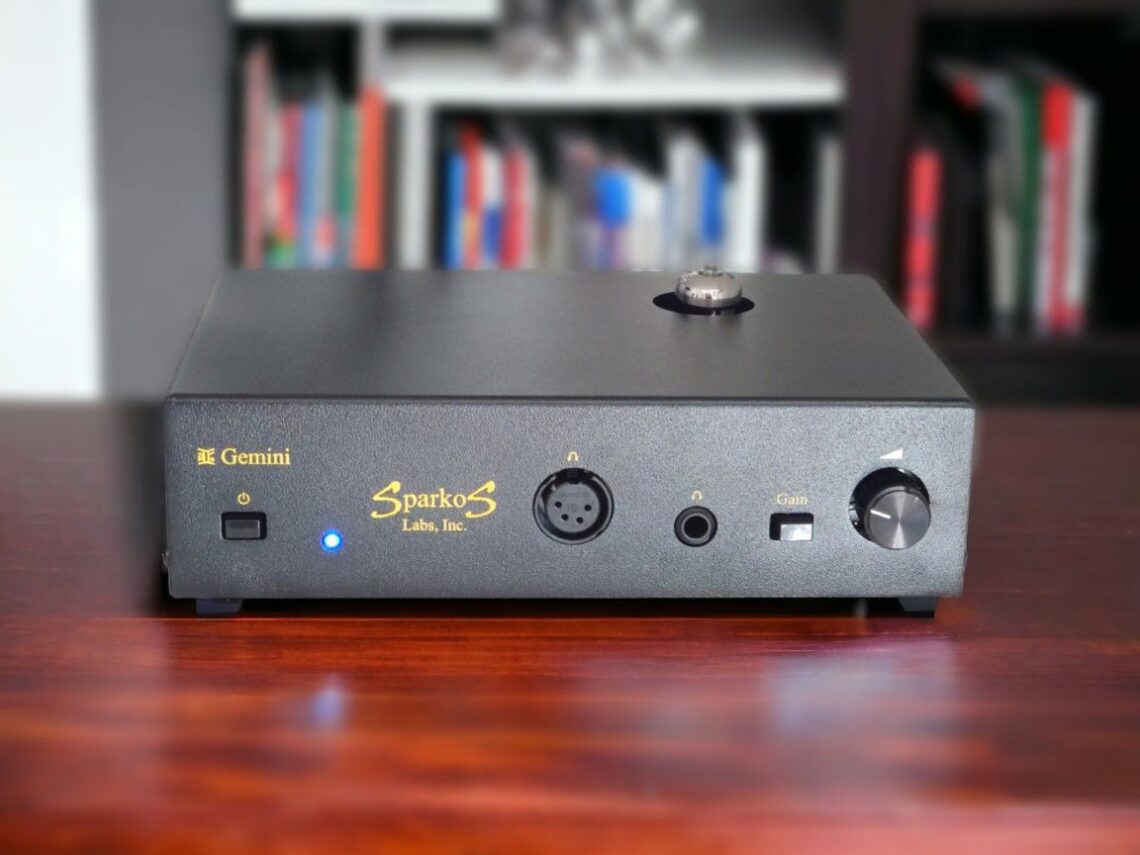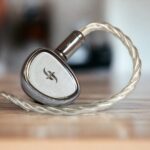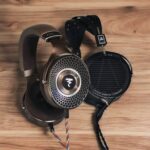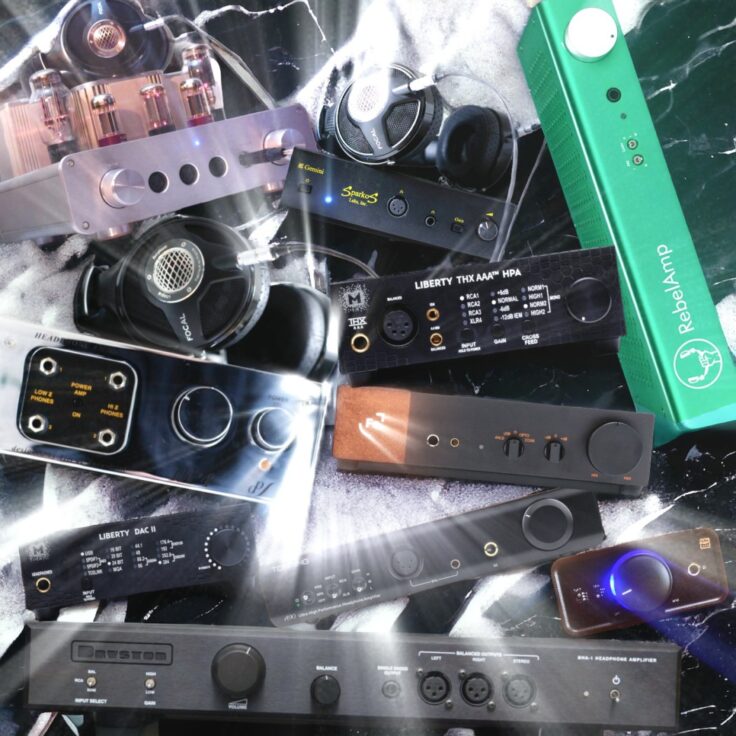The Gemini hybrid headphone amplifier is designed around a tube-based input stage and an op-amp-based output stage. In this review, the Gemini is tested with a multitude of headphones and compared to several other headphone amplifiers. I can say right away that I was thoroughly impressed.
Sparkos Labs is a small US company that started out making dedicated audio component parts like high-quality audio op-amps.
They entered the world of headphone amplifiers in 2019 with the rather large and expensive Aries. The “full version” (2995 USD) is also a pre-amplifier, while the “base version” (2495 USD) is a headphone amp only.
In 2023, they expanded the line with a more affordable headphone amplifier: the Gemini. It’s priced at 995 USD, and combines a 6922-type vacuum tube based input-stage with Sparkos Labs’ own SS2590 discrete op-amp output-stage.
Op-amp is short for “operational amplifier”. It is an integrated circuit, mostly made of transistors and resistors. It amplifies the input signal to a stronger output signal. Op-amps are used to amplify both voltage and current.
Aside from the Aries and Gemini headphone and preamplifiers, all the products Sparkos Labs offers are component parts: discrete audio op amps, discrete pro op amps, discrete voltage regulators, audio power supplies, and op amp adapters. These parts are used in new products, product upgrades, including vintage audio equipment, and in DIY projects. Importantly, some are, of course, used in the Aries and Gemini.
The Gemini headphone amplifier is equipped with RCA inputs and RCA preamp outputs on the back. On the front, you find two headphone outputs: a ¼” / 6.35mm TRS and a 4-pin XLR. There is also a power button and a gain control button where the user can set the gain to high or low, which will affect the noise floor, volume level and also to some extent, the characteristics of sound.
The internals incorporate a 6922-type vacuum tube in the input stage. Sparkos Labs encourages tube rolling and has a user-adjustable tube-bias regulator inside for customization of the appropriate bias and, to some extent, to adjust the degree of “tube sound.”
The output stage is designed around Sparkos Labs SS2590 discrete opamps and their discrete voltage regulators. The Gemini uses an Alps Blue Velvet volume control pot. The design features zero global feedback and has no capacitors in the signal path.
Other notable features include a tube-heater soft-start with a 40-second tube warm-up delay. There’s DC protection for the headphone outputs. The Gemini boasts a very low output impedance of less than 0.25 ohms, which gives it a high damping factor for any headphone.
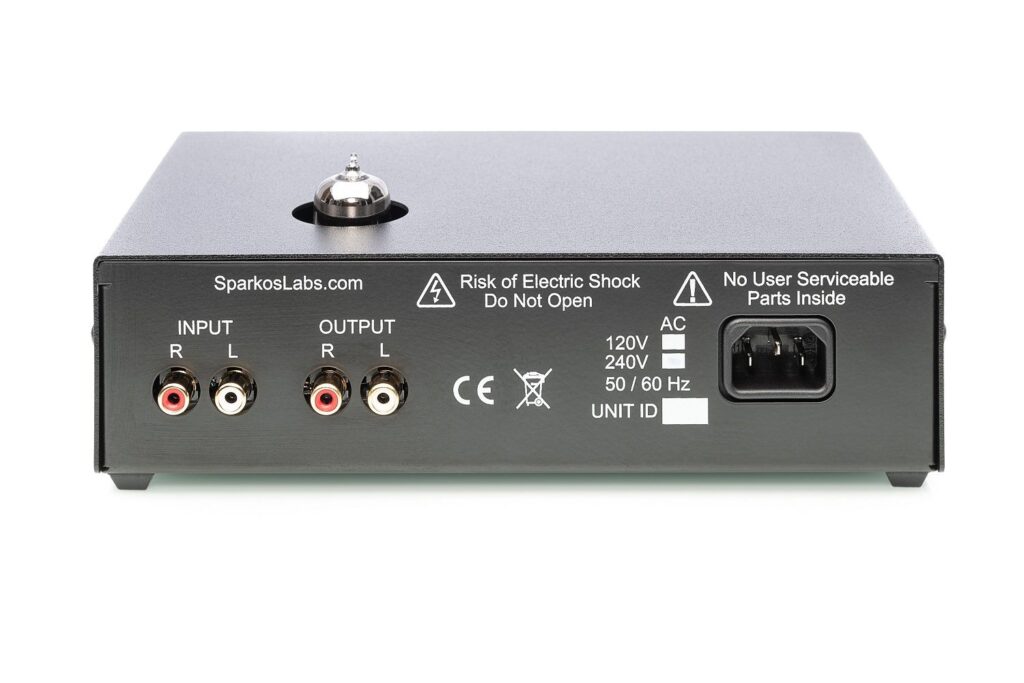
SPARKOS LABS GEMINI SPECIFICATIONS AND ESSENTIALS
- 1 pair of RCA inputs
- 1 pair of RCA preamp outputs
- 1 x ¼” Headphone Output
- 1 x 4-pin XLR Headphone Output
- Alps Blue Velvet Volume Control
- Sparkos Labs SS2590 Discrete OPA Output Stage
- Sparkos Labs Discrete Voltage Regulators
- Zero global feedback
- 6922 Vacuum Tube (front-end, allows for tube rolling)
- User adjustable tube bias point (internal)
- Tube Heater Soft Start, 40-second tube warm-up delay
- Gain Control Button (high or low)
- Gain: 12dB (Low Gain) And 21.5dB (High Gain)
- DC protection for the headphone outputs
- Output Impedance < 0.25 ohms
- 10Hz – 100KHz Frequency Response
- Unloaded Cross Talk >100dB @ 1KHz
- Power Out 2 Watts Max @ 32Ohms
- Power Out 750mW Max @300 Ohms
- 15V Peak Output Voltage
- 250mA peak output current
- THD 0.1% – 1.5% depending on settings
- Metric size: 23cm Wide, 15cm Deep, 6.4 cm Tall
- Imperial size: 9” Wide 6” Deep, 2.5” Tall
- Input: 120 / 240 VAC Operation
The test unit was a long term loan from the local distributor, moiz.audio
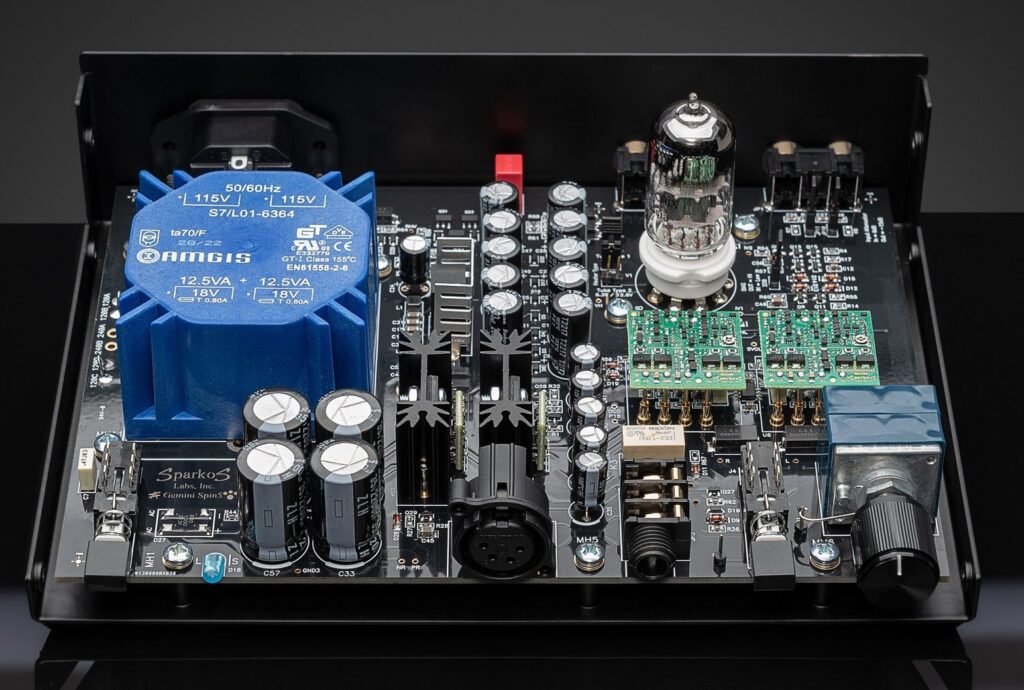
BUILD AND DESIGN
The Gemini is an unbalanced design, and that is a good thing. It means that the money is spent on better parts rather than the “unnecessary” components needed to make an amplifier “truly balanced”.
It also means that you have the advantage of getting full power performance from the unbalanced output. Still, there is a 4-pin XLR output, but that is for convenience only. I really like that.
The box itself is very simple, and the design is very utilitarian, with a powder-painted black metal chassis. However, I must say that I think it looks better in real life than in pictures. It feels very sturdy and of high quality. The volume knob and buttons feel reassuringly solid.
In order to change the vacuum tube or adjust the bias, you will have to dismount the cover. There are also several jumpers that might need to be adjusted according to which type of tube you use.
LISTENING SESSIONS
In the following, I will explore how the Gemini performs with a range of headphones, comparing it to other headphone amplifiers. The main points of reference will be the Topping A90 and the Mytek Liberty THX AAA HPA amp, but I will also compare the Gemini to other amplifiers.
The gain button setting (high or low) will affect the sound. In my comparisons, have used the setting which sounded the best to my ears. With a few very sensitive headphones, the noise floor with high gain was too high for it to be a choice.
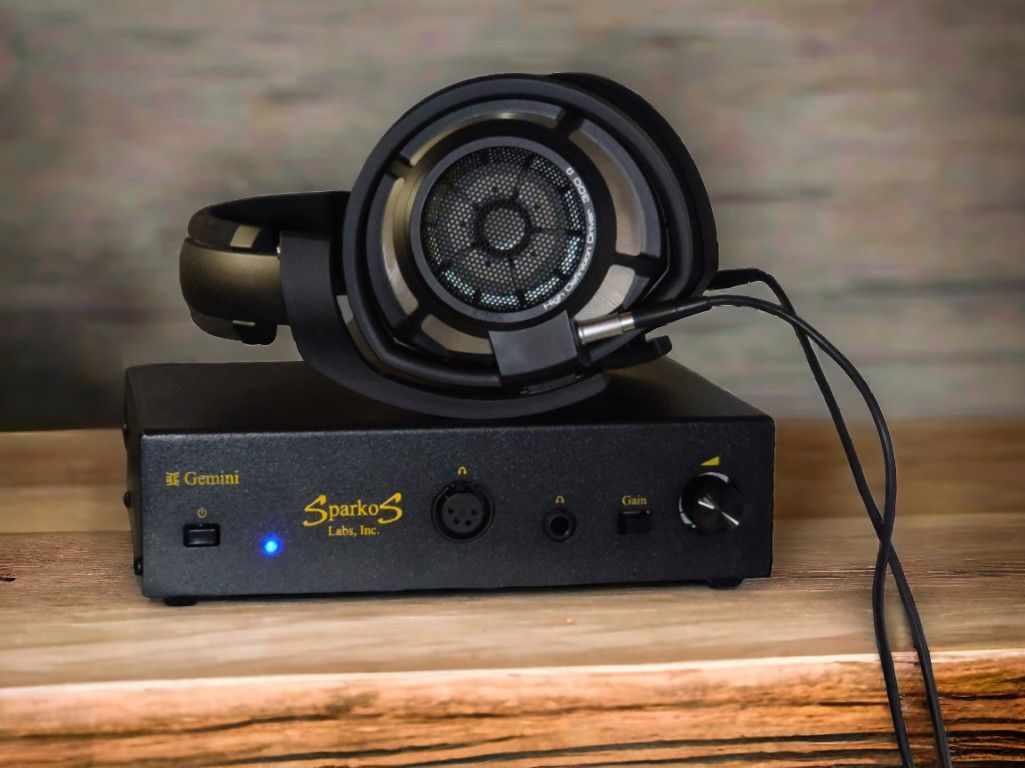
SENNHEISER HD800S and HD800
My top amplifiers for the HD800 and HD800S are the solid-state Bryston BHA-1 and the tube EAR HP4. The small-sized Sparkos Gemini performs, as far as I can tell, at a similar level as those two way more expensive amps. All three sound excellent with the HD800S, but they are clearly different:
The BHA-1 is a very good solid-state amplifier. It’s crisp and tight, with lots of micro details and dynamics. That being said, I tend to find solid-state amplifiers to make the HD800S sound clinical and a bit thin and bright. The BHA-1 is one of the better solid-state amps I’ve tried with the HD800S, so there is nothing wrong with the Bryston BHA-1, but rather the fact that I find a good tube amp to sound more pleasing with the HD800S.
When I go from the BHA-1 to the Gemini, I find it to be an improvement. The Gemini is more organic, a bit richer, and less edgy. The treble is less fatigue-inducing, the mid-range a bit sweeter, and the bass a tad fuller.
The Woo WA22 has an even richer to tonality than the Gemini, but not at the cost of details. Unsurprisingly, the Gemini sounds somewhere between the all-tube WA22 and a high-quality solid-state amp like the Bryston BHA-1. Personally, I find the WA22 to sound the best, more organic, but the Gemini is also stellar. Both do a great job and take the edge off the famous treble peak/bright sound the HD800S and HD800 often has, even with great solid-state amps. I find the Gemini a great middle point.
Comparing the Gemini to the Mytek Liberty THX AAA Amp, I am surprised by how similar they sound. I expected that the Gemini would be better, but the Liberty is a great solid state alternative, with stellar control and a slightly warm tonality. I have tested most of the Mytek DAC/Amps before, and they all do well with the HD800 and HD800S, so, it doesn’t come as a huge surprise that the Liberty does too.
Buy on Amazon: Sennheiser HD800S
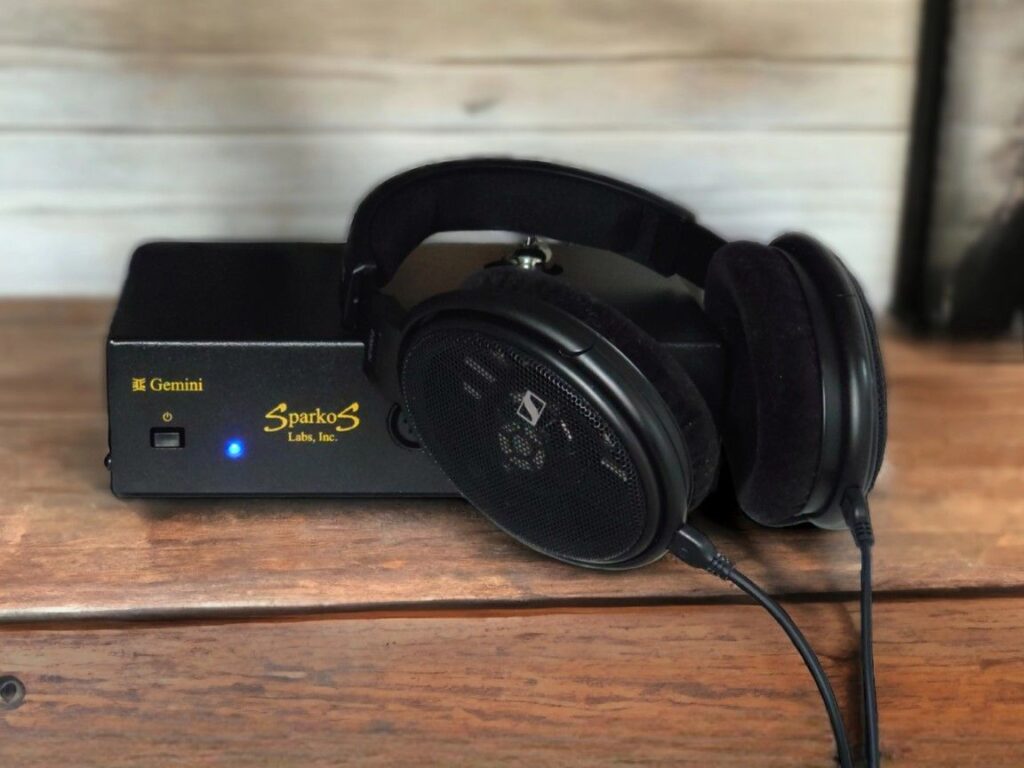
SENNHEISER HD660S
The 150-ohm Sennheiser HD660S becomes incredibly dynamic and organic with the Gemini. The Rebel Amp is a good solid-state amp, but it just doesn’t succeed in bringing out the absolute best in the HD660S as much as the Gemini does. The Mytek Liberty THX AAA Amp also gets a bit flat-sounding when compared to the Gemini with the HD660S.
Listening to dynamic-sounding experimental jazz like Modul 55 by Nik Bärtch’s Ronin or the album Donder by Donder, it becomes especially apparent. The two solid-state amps sound good but don’t bring the HD660S to the same level; it doesn’t become as magical.
SENNHEISER HD660S2
The Gemini is stunning with the 150-ohm HD660S, and it comes as no surprise that it does a great job with the 300-ohm HD660S2 as well. The HD660S2 doesn’t sound as dynamic as the HD660S, but that’s not the fault of the Gemini. Across amplifiers and music, the HD660S2 sounds relatively consistent.
Comparing it to the Rebel Amp and Topping A90 with Tomasz Stanko Quintet’s Terminal 7, they sound surprisingly similar. The Gemini has an edge in terms of treble detail and liquidity. The Mytek Liberty THX AAA Amp sounds similarly resolved in the upper ranges, and it’s the tightest and most detailed sounding of the bunch. Cassandra Wilson’s Black Crow gives the same result. I think the Gemini and Mytek are a bit better than the other two.
Playing Vivaldi Recomposed: Summer 3 by Max Richter, the Gemini sounds a little bit disappointing, however. The Mytek is superior with more clarity and microdynamics. The two others are, if anything, a little bit better than the Gemini as well.
Buy on Amazon: Sennheiser HD660S2
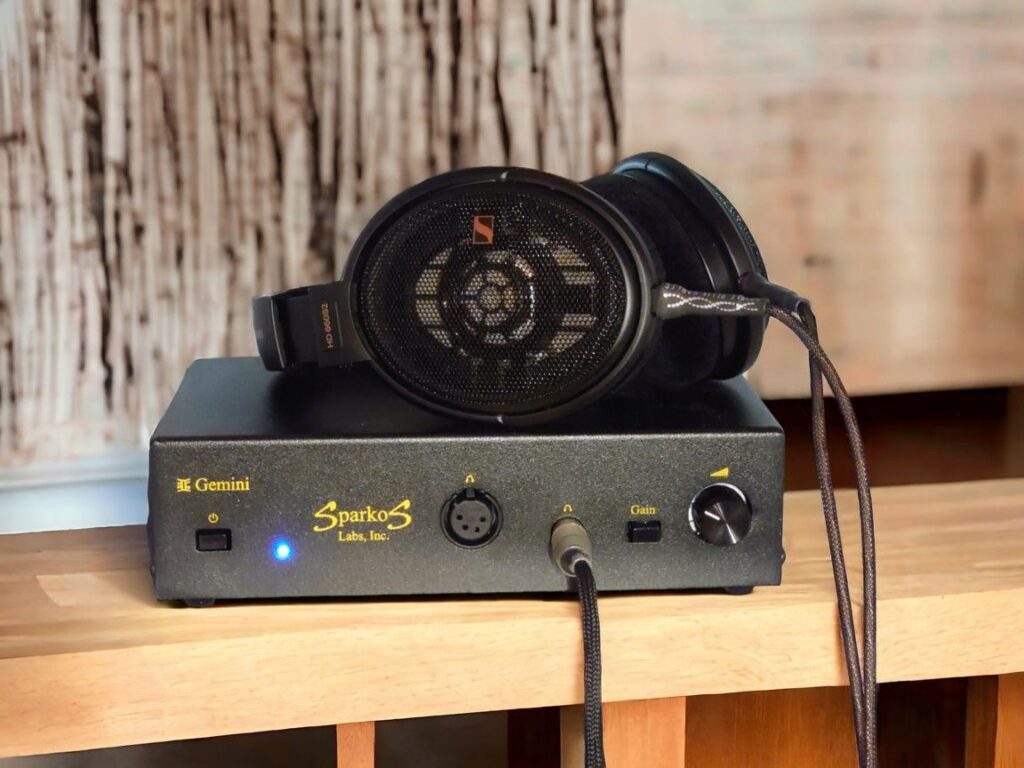
With Jambi by Tool, I prefer the Gemini a bit more than the rest, with the Mytek as a slightly cleaner but less meaty alternative. However, the other two are definitely not far behind.
I continue with various genres, the broad impression here is that HD660S2 isn’t very picky about any of these amplifiers, but the Gemini and the Mytek stand out as a little better. Which I prefer the most of the two depends on the track.
SENNHEISER HD650 and HD6XX
Moving on with the former Sennheiser flagship headphone, the legendary HD650 (which is almost identical to the HD6XX), the Gemini doesn’t hold back. The HD650 is generally more dynamic-sounding than the HD660S2 (I’ll make a thorough comparison another time). It’s immediately clear that the Gemini is a stellar match for the HD650.
The Topping A90, Rebel Amp, and Mytek Liberty amp work well too, but the Gemini has some extra magic. It is like with the HD660S; it has a slightly more dynamic and organic sound while at the same time feeling even more detailed and articulated. The Mytek Liberty Amp is the clearest sounding, but it’s not as organic and dynamic as the Gemini.
Buy on Amazon: Sennheiser HD650
SENNHEISER HD600
The Sennheiser HD600 also sounds stellar with the Gemini. For some reason, the HD600 doesn’t distinguish between the amplifiers I’m using as much as the HD660S and the HD650. I have no idea why it is so, but that’s matching headphones and amplifiers: It’s all a mystery.
That being said, I do find that the HD600 sounds the best with the Gemini. Even though it’s very good with the Topping A90, Rebel Amp, and Mytek Liberty Amp, there is just something about the Gemini. Especially nice with dynamic, acoustic music. The Gemini brings out that little extra bit of something that can make or break the experience from being nice to becoming magical.
Buy on Amazon: Sennheiser HD600
BEYERDYNAMIC AMIRON HOME
I really like these headphones. After having owned both the T1 mk1 and mk2, I parted with them after several years because I found them to be too bright. The 250-ohm Amiron Home is not bright. Rather, it has quite a lush and delicious sound. Very dynamic and quite warm.
The Gemini, drives them fabulously well. Comparing it to the Topping A90, the Gemini is in another league. The Topping sounds flat and a bit anemic. The Rebel Amp and the Mytek Liberty Amp are better, but they also lack the ability to make the Amiron as punchy as the Gemini does.
Buy on Amazon: Beyerdynamic Amiron Home
BEYERDYNAMIC DT1990PRO and DT1770PRO
I find these 250-ohm headphones to be pretty consistent across the amplifiers. The Topping A90, the Mytek Liberty Amp, and the Gemini all drive them with pretty much the same qualities. However, some differences are sometimes notable. With Leonard Cohen’s Almost Like the Blues, you can relatively easily hear that the bass is handled differently. The Gemini has both the most body and the most control, the Mytek Liberty Amp is a close second, while the Topping A90 is definitely not on the same level. However, we are talking about small differences, and for the most part, the amplifiers sound almost the same.
Buy on Amazon: Beyerdynamic DT1990PRO
Buy on Amazon: Beyerdynamic DT1770PRO
FIIO FT3
The FT3 is the first headphone from FiiO, and they definitely succeed on their first try with a great-sounding set. Starting out with the Schiit Magni Heretic, things already sound great, sounding better than the Topping A90, which is a bit flat and boring.
With an impedance of 300 ohms, the FT3 should pair well with tubes, and the Gemini does a remarkably good job. It’s a good step up from the previous mentions and really brings out true greatness from the FT3. The Mytek Liberty Amp is in the same league, but I prefer the Gemini.
Buy on Amazon: FiiO FT3
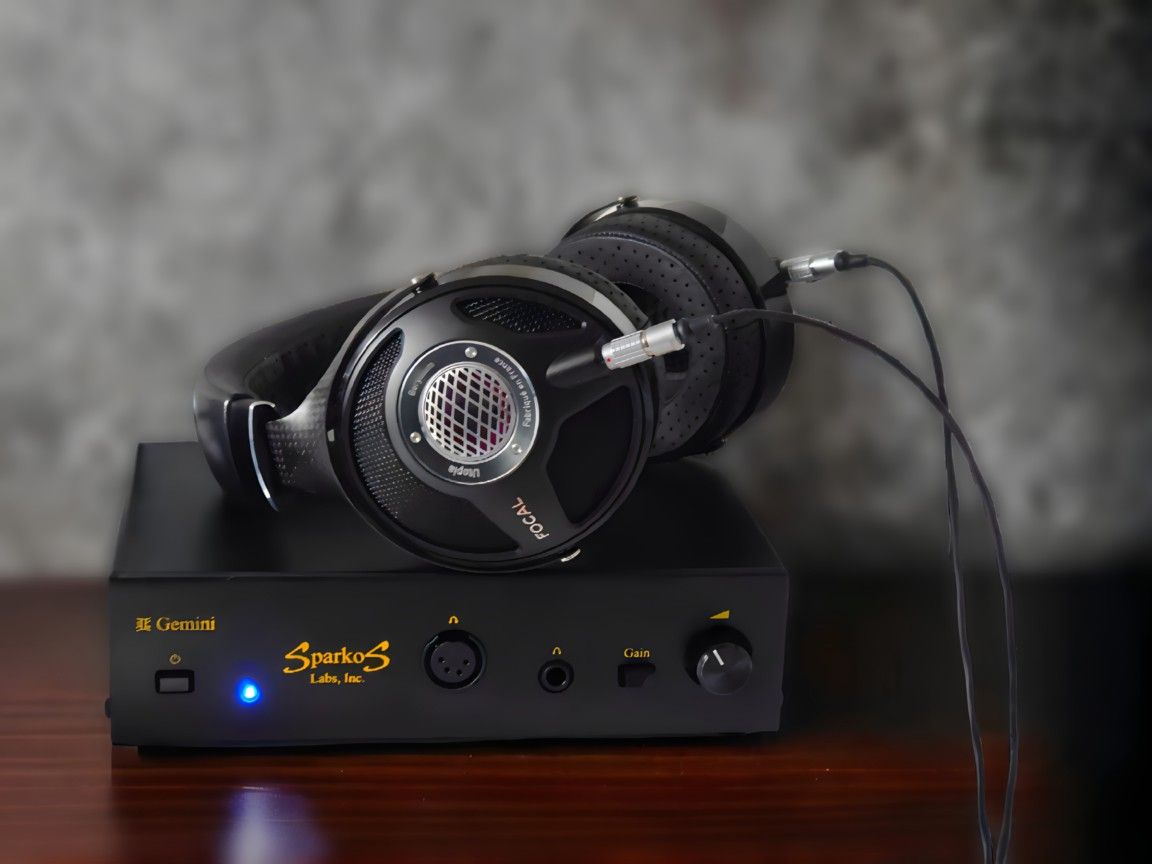
FOCAL UTOPIA
The Gemini pairs really well with the dynamic 80-ohm/104dB Focal Utopia. It has plenty of power and headroom. It isn’t as ultra-clear as the Mytek Liberty THX Amp or the Ferrum Erco – both are among my absolute favourite amps for the Utopia. However, the Gemini does make the edges a little less sharp – in a nice way., There’s also more glow to many instruments, like the electric jazz guitar on Todd Sickafoose’s Magnetic North. The Gemini gives you a great blend of tubes and solid-state, it’s a fantastic amp, and it makes the Utopia sound fabolous without breaking the bank.
Buy on Amazon: Focal Utopia
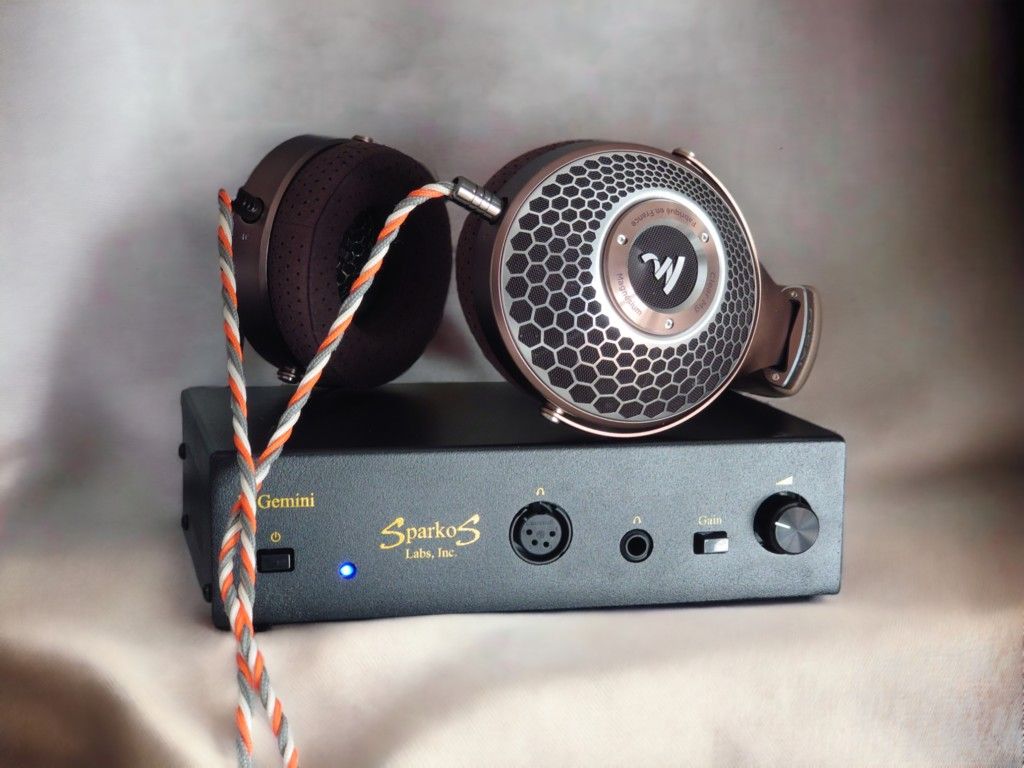
FOCAL CLEAR MG and ELEX/ELEAR
The 55-ohm Clear MG and the 80-ohm Elex/Elear, both 104 dB, are Focals affordable versions of the flagship Utopia.
The Dark Eyes album by Tomasz Stanko Quintet sounds extremely spacious and detailed. The imaging is superb. Comparing it across different tracks to the Topping A90 and the Rebel Amp, I think they all do a good job, but the Gemini stands out with a more liquid and slightly thicker sound, while at the same time managing to be more detailed and dynamic.
When I compare the Gemini to the Mytek Liberty Amp, I find they are on the same level in terms of detail retrieval and dynamics, but they have slightly different characteristics that are typically associated with solid-state versus tube amplifiers: The Mytek is tighter and more textured, and the Gemini is warmer and more liquid.
Buy on Amazon: Focal Clear MG
AUDEZE LCD-X
The planar magnetic, 16-ohm/103 dB LCD-X is one of Audeze’s most successful headphones ever. I adore the way it sounds with the Gemini. There is just something extra about the Gemini that brings out the sweetness from the headphones that the solid-state amps, Topping A90, Rebel Amp, and Mytek Liberty Amp just cannot match.
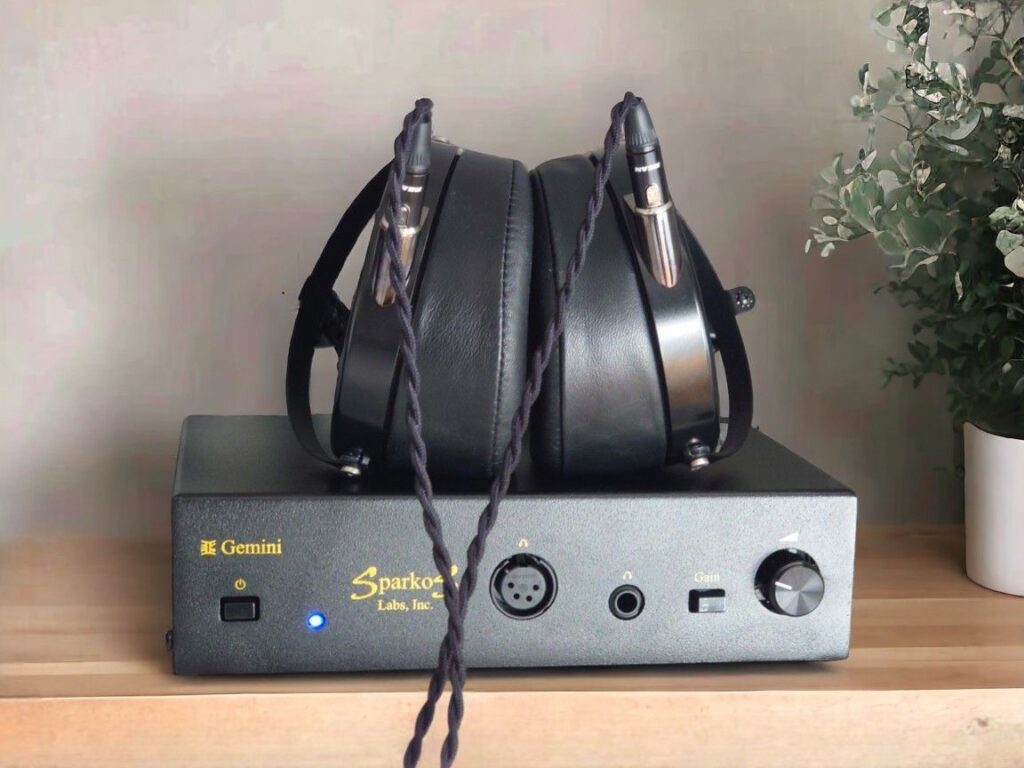
The Gemini is dynamic and detailed, while still giving that slight sense of organic niceness to everything. The mid-range is a little bit thicker and sweeter; the details are all there but presented in a more liquid way.
Buy on Amazon: Audeze LCD-X
HIFIMAN SUNDARA and HE-560
These are planar magnetic headphones. With both the 32-ohm/94dB Sundara and the 45-ohm/90dB HE-560, there is a significant increase in dynamics and clarity when I move from the Fiio K5, Schiit Magni Heretic, Topping A90, and Rebel Amp to the Sparkos Gemini. The music is more alive and better articulated. There is more detail in the background.
Buy on Amazon: Hifiman Sundara
HIFIMAN HE-6 SE
It’s always fun to see how an amplifier handles one of the most difficult headphones to drive ever made. The HE-6 SE is rated as 50 ohm/83.5 dB, and many enthusiasts (like myself) often use it with a powerful speaker amplifier.
To my big surprise, the Gemini actually performs very well with the HE-6 SE. Not only does it drive it with power to spare in terms of volume, but it also drives it with authority.
I had not expected that the Gemini would turn out to be one of the better dedicated headphone amplifiers I’ve heard for the HE-6 SE. The Topping A90 isn’t even close, the Mytek Liberty Amp struggles too.
The Bryston BHA-1, on the other hand, is one of the few dedicated headphone amplifiers that brings the HE-6 / HE6SE close to the level of what good speaker amps manage. It has more juice and sounds tighter than the Gemini.
Moving over to speaker amps, I first compare the Gemini to the Schiit Vidar 2 100W stereo power amp. I really like the Vidar 2 with the HE-6; the Gemini isn’t at the same level but still impresses me by being somewhat in the same ballpark.
Compared to my favourite, the Cary SLI-80 Signature, the Gemini isn’t in the same league, but I’m still extremely impressed.
This was totally unexpected, but I am not kidding you. The Sparkos Labs Gemini hybrid tube amp can drive the Hifiman HE-6 SE with control and authority and with headroom to spare.
HIFIMAN HE1000v2, HIFIMAN EDITION XS
These are planar magnetic headphones measuring 35 ohm /90 dB for the HE1000 v2 (pre-stealth) and 18 ohm/92 dB for the Edition XS.
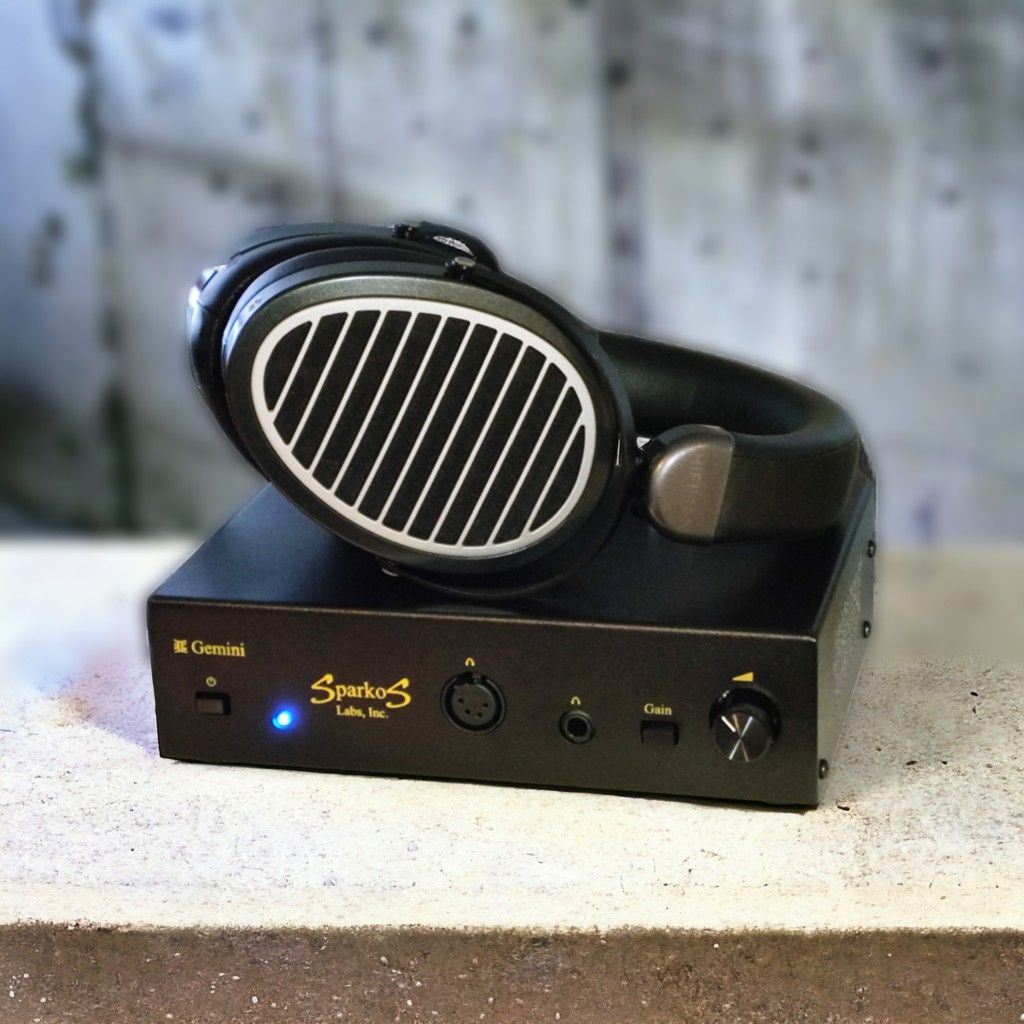
I really like the way the Gemini makes these headphones sound. They get a bit warmer and more organic with the Gemini than with the Topping A90 or Mytek Liberty Amp. The treble is smoother than with the Topping A90. The Mytek has its strengths, especially with regard to fine detail, but the tonality is more to my liking with the Gemini.
Buy on Amazon: Hifiman XS
Buy on Amazon: Hifiman HE1000
DAN CLARK AUDIO ETHER 2
The 16-ohm/92 dB planar magnetic Ether 2 is a fabulous-sounding headphone that has not gotten the attention it deserves, maybe because it has been priced a bit high. I really like the design and build, especially the circular cups, which fit me better than the oval shaped ones.
Anyway, the Gemini does a fantastic job. I am beginning to run out of superlatives. It is detailed and dynamic, with a great tonality.
Comparing it to the Topping A90 and the Rebel Amp, the differences are not enormous, but the Gemini feels more alive. The Mytek Liberty Amp sounds very good, but not as organic.
DAN CLARK ETHER CX
You’ll be hard-pressed to find a technically better closed back headphone with good passive noise isolation for the money than the planar magnetic, 23-ohm/92 dB Drop DCA Ether CX. I did, however, find that it required some experimenting with the tuning pads to get the tonality right, and I actually ended up using some 3rd-party foam, but then it got perfect for my ears.
The Gemini drives the CX wonderfully. Tight and spacious. It’s not a warm-sounding headphone, though, and the Gemini doesn’t transform it, but it does add some more body to the music than the Mytek Liberty Amp and the Topping A90. Actually, I find the Topping to sound at least as good as the Liberty for a change. I also make a new observation, that the Liberty interestingly sounds slightly more full-bodied with the gain set to +6. However, the Gemini is my favourite.
Buy on Amazon: Dan Clark Ether CX
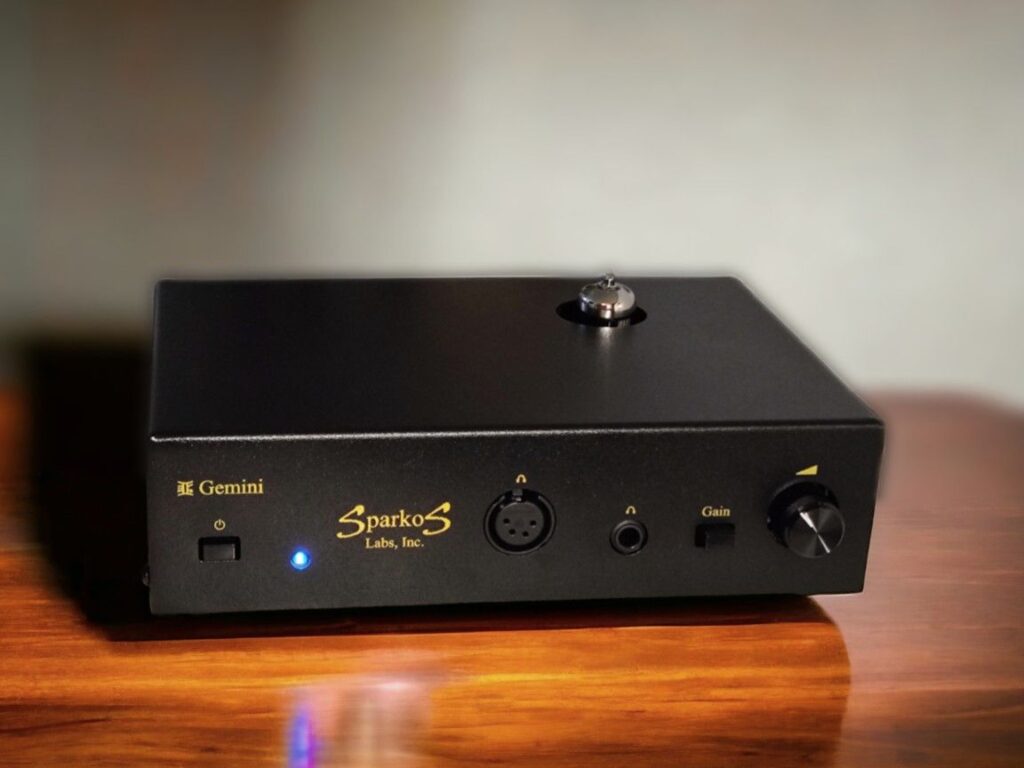
MEZE 109 PRO
The 40-ohm/112dB dynamic Meze 109 PRO is quite sensitive, and I have to set the gain to “low” on the Gemini to avoid hiss. Listening to the 109 PRO with the Gemini, Topping A90, Rebel Amp, and the Mytek Liberty Amp, there are no huge variations. These headphones are seemingly pretty flexible with regards to the amplifier, so all four amps do a very good job. Although the Gemini might stand out as my favorite, mainly because of its slightly meatier sound, it is not preferred by a large margin, and definitely a very subjective preference of tonality.
Buy on Amazon: Meze 109 PRO
DENON AH-D9200
Also with the D9200 (24-ohm/106 dB), you need to set it at low gain to avoid a slight hiss; with that, there is no issue. The Gemini does have a very low output impedance of 0.5 ohms, so even the 24-ohm Denons have a large damping factor.
D9200 sounds wonderful with the Gemini. It’s very spacious and detailed, with a touch of that tube liquidity and some midrange sweetness. Not much, though; it is not an amplifier that really colours everything. It just adds a little touch.
The Mytek Liberty Amp is also really nice with the D9200; I cannot really say I prefer one over the other. The Mytek has slightly more detail, and the Gemini has a little bolder sound. The differences aren’t really big, though.
The Topping A90 does quite well too, but the other two are better.
Buy on Amazon: Denon D9200
DENON AH-D5200
The D5200 (24 ohm/103 dB) is along with the D7200, the D9200’s little brother. I expected it to give the same results. However, I find the Topping A90 to be preferable to the Gemini. It’s cleaner without sounding clinical or less warm. Even the Mytek isn’t any better than the Topping with the D5200; rather, it feels a bit thicker too – in the wrong way.
Buy on Amazon: Denon D5200
GRADO GS1X
Grados aren’t like other headphones. And the RSX1 (38 ohm/99 dB) sure is picky on the amplifier. The Gemini and the RS1X, at least, aren’t best friends. My Rebel amp, on the other hand, does great. The Topping A90 is also quite good. The Mytek Liberty Amp isn’t silent enough, even at -12 dB gain, which just isn’t acceptable. I might have local issues with noisy AC power, but none of my other amps have such a high noise level.
Anyway, the Grado RS1X is one of very few headphones that, in my ears, sound far from optimal on the Gemini, for whatever reason. It sounds flat and uninspiring. The Schiit Magni Heretic sounds more dynamic and detailed, the headphone output from the RME ADI-2 DAC FS even better, actually it’s really good. I have no other Grados to try, but this was a surprisingly bad match with the Gemini.
Buy on Amazon: Grado RS1X
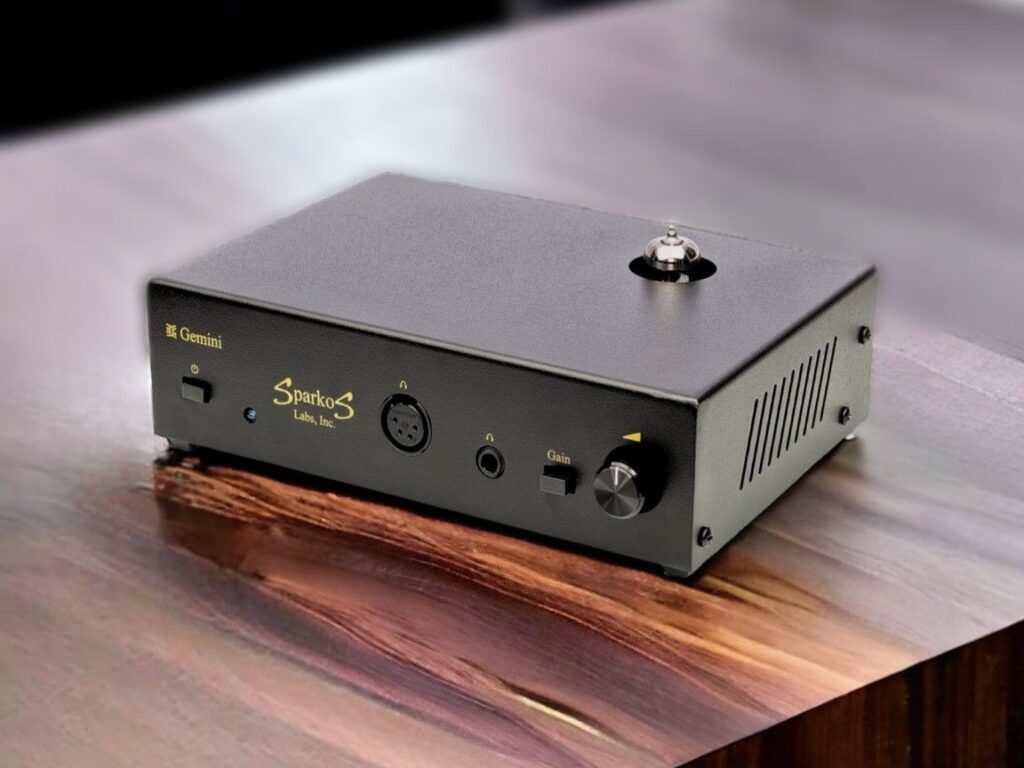
FOSTEX TH900 mk2
The Fostex TH900 (20 ohm/100 dB, mk1 and mk2 are identical except for the cable) has no issue with background noise on low gain. The sound is very clean, and if anything, it is clearer sounding than the Topping A90, Rebel Amp and even the Mytek Liberty Amp. I prefer the Gemini over the others.
Buy on Amazon: Fostex TH900 mk2
SHURE SRH-1840
I do not know why these headphones have not gotten more appreciation; they are certainly on the level of the Sennheiser HD6**-series; they’re well-built and comfortable. SRH 1840 is 60 ohms and 100dB/V. The Gemini drives them with ease and grace. However, I do find that the Topping A90 and the Mytek are even a little bit better; they sound cleaner, or rather more polite, while the Gemini is more bold. Actually, I prefer the A90 of the three, it is very neutral, and somehow it suits these headphones.
Buy on Amazon: Shure SRH-1840
AUDIO TECHNICA ATH-R70X
This is another headphone that, in my opinion, deserves more attention. It’s got an unusually high impedance of 450 ohms, but it’s not very picky on the amplifier. It sounds absolutely wonderful with the Gemini. However, the Mytek Liberty Amp also does a terrific job, with the Topping A90 not far behind. My favorite is the Gemini, though. It’s got a little more fullness and sounds a bit more alive.
Buy on Amazon: Audio Technica ATH-R70X
QUAD ERA-1
This is another fabulous-sounding headphone that has not gotten as much attention as I think it deserves. It is a low-impedance, high sensitivity planar magnetic headphone. Even though it’s specified as 20 ohm / 94 dB/mW, it’s one of the few headphones I know that sounds great from my LG V40 phone’s headphone jack.
Playing Magnus af Uggla’s fantastic guitar-based instrumental album Works 4, Gemini does a great job. Comparing it to the Mytek Liberty Amp, the Gemini sounds a little bit bolder, but they have roughly the same amount of detail and dynamics. Moving over to the Topping A90, things still sound marvelous. Tonality-wise, the Topping is the farthest away from the Gemini. It’s not as meaty, but still very good. I think all three amplifiers do a very good job with this quite flexible headphone; the level of detail and technical finesse are similar, and even though there are small differences, they sound more alike than not.
Full Review: QUAD ERA-1
AKG K701, K702, and Q701
These three headphones are as good as identical when it comes to sound. They share the same driver, and almost anything else. I suspect the only sonically relevant difference could be the tuning foam.
The Gemini drives the AKGs with authority and makes them sound relatively full-bodied. They are notoriously known for needing quite a lot of power to really shine and get the dynamics and punch they are able to, and the Gemini certainly delivers the goods.
The Mytek Liberty Amp also drives the AKGs very nicely, but not with the same bold, meaty fullness. The Topping A90 is okay, but not more than that. It sounds a bit anemic in direct comparison to the two other alternatives.
In conclusion, I think the Gemini is one of the better amplifiers I have heard for the AKG K701/2s.
Buy on Amazon: AKG K702
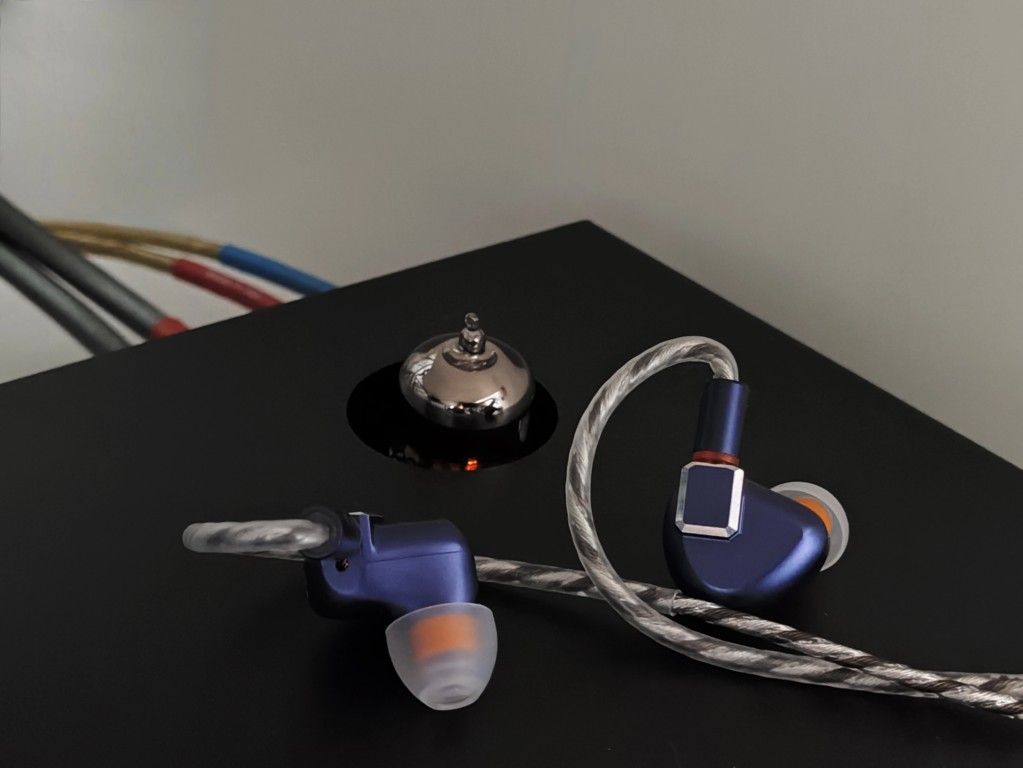
GEMINI WITH IEMs
The Gemini is not made especially for in-ear monitors, and sensitive IEMs will get audible hiss. However, less sensitive IEMs work well.
The Letshuoer S12 PRO is a 12mm planar-magnetic single-driver IEM with 16 Ohms impedance and 102 dB/mW. It sounds extremely good, with no hiss at all, and I’ve never heard them sound better.
Tinhifi P1 is a 10 mm planar diaphragm with an impedance of 20 ohms and a very low sensitivity of 96 dB/mW. The P1 also sounds great.
TANGZU Wu Zetian is another planar magnetic single driver headphone, with a whopping 14.5 mm diaphragm. At 16 ohms and a sensitivity of 100 dB/mW, there’s no issue with hiss. It’s got a monstrous bass, and the Gemini doesn’t hold it back.
Sennheiser IE 200 is 18 Ohms and 101 dB/mW. It works well with the Gemini, sounding good – with no hiss.
The Simgot EA2000, on the other hand, doesn’t go well with the Gemini. The noise floor is simply too high for this 23-ohm single-dynamic driver earphone with a pretty high sensitivity of 114 dB/mW.
From my small sample of observations, the Gemini has no issue with hiss for IEMs that are less sensitive than 102 dB (possibly higher, too), but with those, it performs excellent.
- Buy on Linsoul: Simgot EA1000
- Buy on Amazon Simgot EA1000
- Buy on Amazon: Sennheiser IE200
- Buy on Amazon: Letshuoer S12 PRO
- Buy on Linsoul: Letshuoer S12 PRO
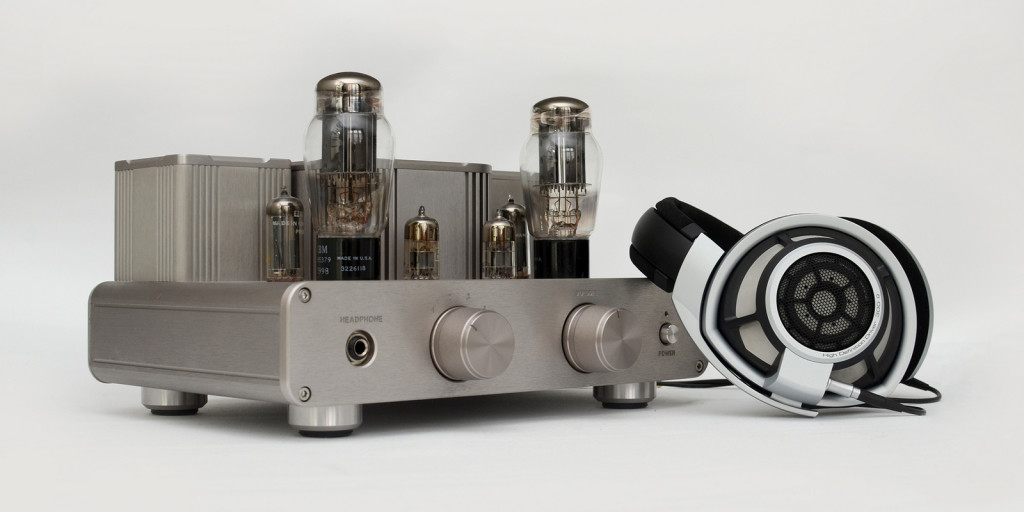
WOO WA2 vs. Sparkos Labs Gemini
Having compared the Gemini to a range of solid-state amplifiers, I want to dedicate some paragraphs to a comparison with the Woo Audio WA2 tube amplifier. The WA2 costs 1499 USD and my unit has upgraded tubes that makes the total cost more than twice the cost of a Gemini.
The WA2 is a modern classic. It’s an OTL tube amplifier. OTL means “output transformer-less” simply because the amplifier does not have any output transformers. In many amps, output transformers are used to lower the output impedance and increase the current output for the amplifier to match better with lower-impedance headphones or speakers, as tubes are inherently high impedance and better at delivering voltage than current to put it simply.
Not having output transformers has its strengths and weaknesses. It leaves the output impedance high because vacuum tubes, by design, have a high impedance. The good part is that you remove the transformers from the signal path.
If you have a high-impedance headphone, a quality OTL amplifier is considered among the best you can get. The high output impedance of the WA2 (around 70 ohms, depending on the tubes) makes it on paper far from optimal with lower impedance headphones.
However, it’s not always the case that the result is bad. Especially with planar magnetic headphones, which are generally less sensitive to the amp’s output impedance. The Hifiman HE-500 sounds terrific with the WA2. Further, and more surprisingly, the Denon D9200 actually sounds truly great.
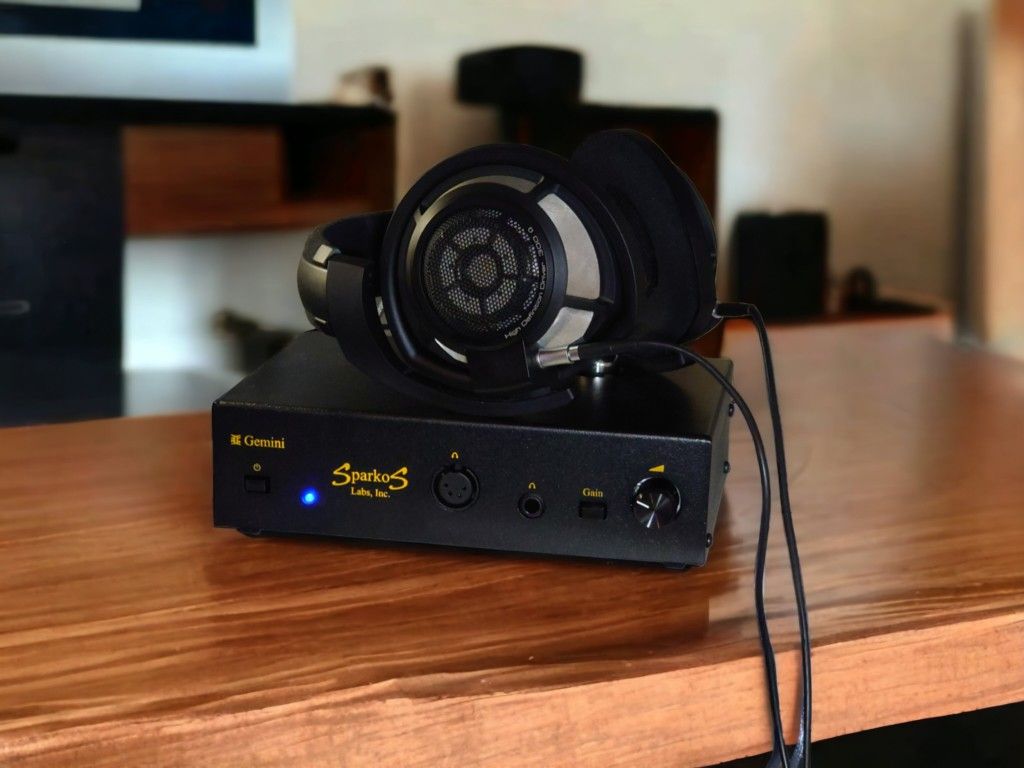
Here’s how I find the Woo Audio WA2 and the Sparkos Labs Gemini to compare with a selection of headphones:
HIFIMAN HE-500
Both WA2 and Gemini perform very well, with WA2 offering more fine nuance and delicacy and Gemini a slightly meatier presentation.
DENON AH-D9200
Surprisingly an excellent match with WA2, providing aspacious and detailed sound with lots of micro-detail (plankton). Gemini also makes the D9200 sound great, with a bit tighter bass, bolder mids, and less refined highs.
SENNHEISER HD580, HD600, HD650/HD6XX, HD660S, and HD660S2
WA2 generally offers a more delicate tonality and finer resolution of details, while Gemini leans towards a bolder sound. Differences are often subtle but noticeable.
SENNHEISER HD800 and HD800S
Putting on the HD800S and HD800, the differences are similar to what I found with the the HD6** series. However, I find that the differences are more pronounced with the more resolved HD800/S.
With classical and acoustic music, the WA2 is fantastic. The Gemini is good, but it cannot match the airiness and delicacy of which the music is rendered with the OTL tube amp.
With more noisy rock and metal tracks like Smile by Pearl Jam or Jambi by Tool, the meatier presentation of the Gemini might be preferable, but listening to more rock it is not consistent, so it isn’t only a matter of genre. Identikit by Radiohead, e.g. sounds better with the WA2.
In conclusion, with the HD800/S, the Woo WA2 offers a more delicate and finely nuanced presentation with more micro-detail and plankton, and a bigger soundstage. The Gemini is slightly bolder and still very good. The differences are not huge, but they are significant, and I think the WA2 defends its higher price when combined with the HD800/S.
AUDIO TECHNICA ATH R70X and SHURE SRH1840
Both amplifiers provide similarly great performance with these headphones, with no significant differences to report.
CONCLUDING, the Gemini certainly gives performance on a very high level. Keeping in mind that my WA2 with the installed tubes is more than twice the cost, I am again very impressed. I generally do prefer the WA2, but the Gemini is not far behind in detail and resolution, and it has a slightly warmer and fuller tonality.
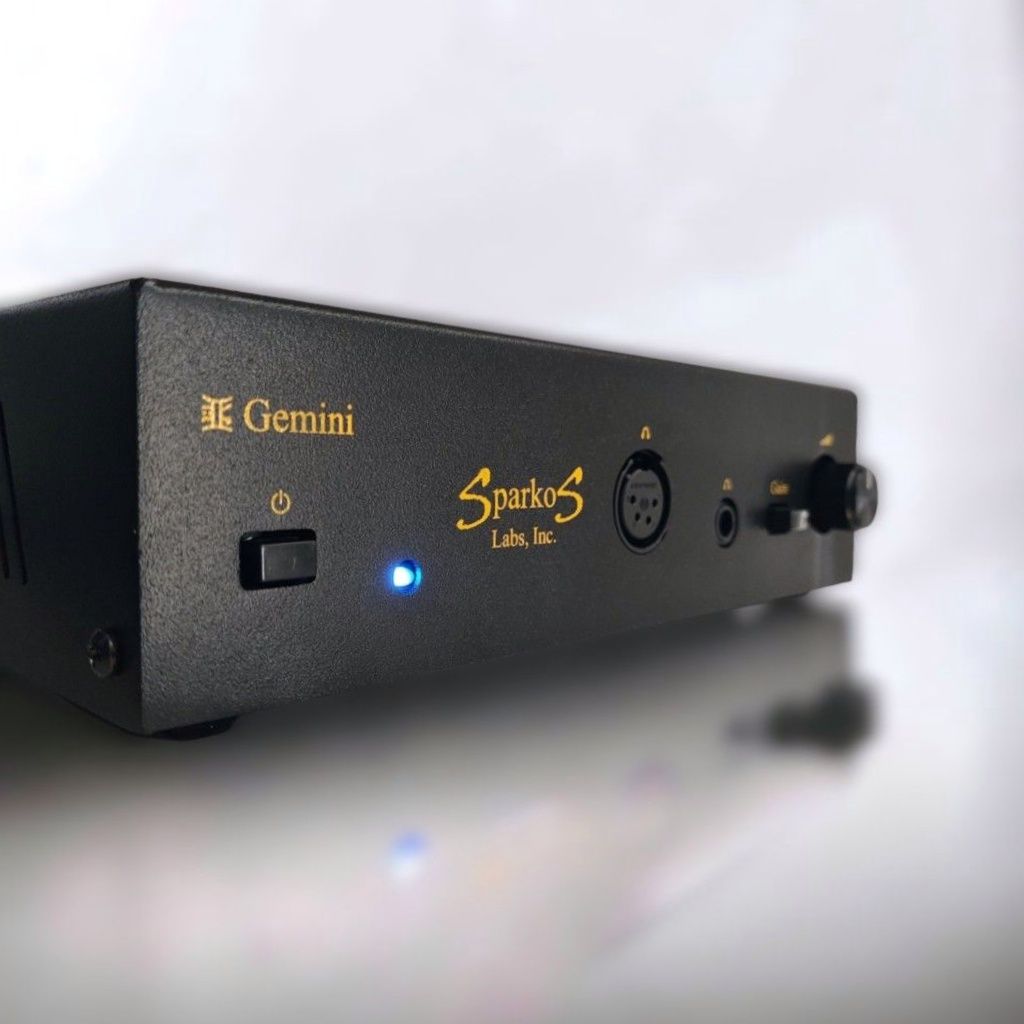
CONCLUSION
The Sparkos Labs Gemini headphone amplifier is a thoroughly impressive unit. It plays extremely well with almost all headphones in the test, whether they have low or high impedance or low or high sensitivity. Regardless, the Gemini sounds great. It is very powerful and dynamic, deliciously detailed, and has a great tonality. Seldom have I come across an amplifier that sounds this good with such a variety of headphones.
The Sparkos Labs Gemini headphone amplifier comes highly recommended.
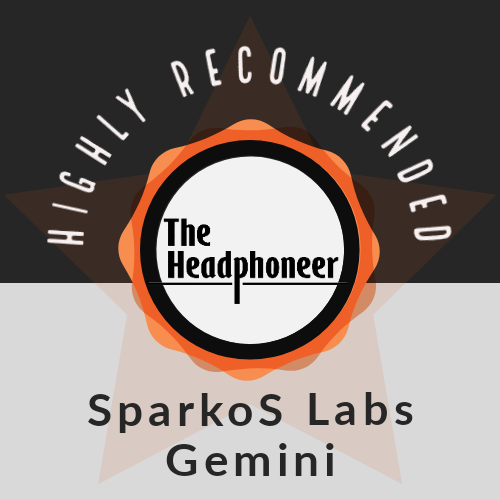
Sparkos Labs Gemini info page found here
Gemini user manual here
We make earnings through affiliate links and any purchase you make on Amazon or Linsoul clicking one of our links will give us a small provision at no cost to you.
We only get a provision for items that are not returned, so there’s no incentive for us to recommend something that’s not good.
Linsoul : Headphones, Earbuds, Wireless Earbuds, Desktop DAC/AMP, Portable DAC/AMP, Digital Audio Players,
Amazon: Headphones, IEMs, Headphone Amplifiers, Home Audio or Anything else.
.
If you enjoyed this article or other content on The Headphoneer, you might consider leaving a small donation to keep this website up and running. No donation is too small. Thanks for supporting us!
If you like our work please follow us on Instagram, Facebook and Twitter , it will help us grow. Sharing is caring 🙂


